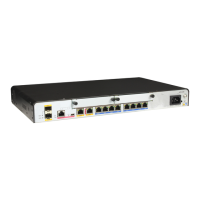Context
Run the following commands in the system view to notify the Network Management System
(NMS) of LSP status changes.
By default, the trap function is disabled during the setup of the LDP LSP.
Procedure
l Run the snmp-agent trap suppress feature-name lsp trap-name { mplsxcup |
mplsxcdown } trap-interval trap-interval [ max-trap-number max-trap-number ]
command in the system view to enable the trap function for the LDP LSP and enable the
debugging of excessive mplsxcup or mplsxcdown information.
----End
2.13 Configuration Examples
The following sections provide several examples for configuring MPLS LDP. Familiarize
yourself with the configuration procedures against the networking diagram. Each configuration
example consists of the networking requirements, configuration precautions, configuration
roadmap, configuration procedures, and configuration files.
2.13.1 Example for Configuring Local LDP Sessions
This section describes how to configure local LDP sessions, including how to enable MPLS and
LDP on nodes and interfaces.
Networking Requirements
As shown in Figure 2-3, LSRA, LSRB, and LSRC are core routers on an MPLS network. A PE
transmits data traffic to the MPLS network. Before establishing an LSP to forward data traffic
within the MPLS network, configure local LDP sessions between LSRA and LSRB, and LSRB
and LSRC.
Addresses of interfaces are planned for LSRA, LSRB, and LSRC shown in Figure 2-4.
Figure 2-3 Networking diagram for a local LDP session (I)
CE
CE
CE
Service provider's
backbone
CE
VPN 1
Site
Site
Site
Site
VPN 1
VPN 2
PE
PE
PE
P
LSRA LSRB
VPN 2
P
LSRC
P
Huawei AR1200 Series Enterprise Routers
Configuration Guide - MPLS 2 MPLS LDP Configuration
Issue 01 (2011-12-30) Huawei Proprietary and Confidential
Copyright © Huawei Technologies Co., Ltd.
72

